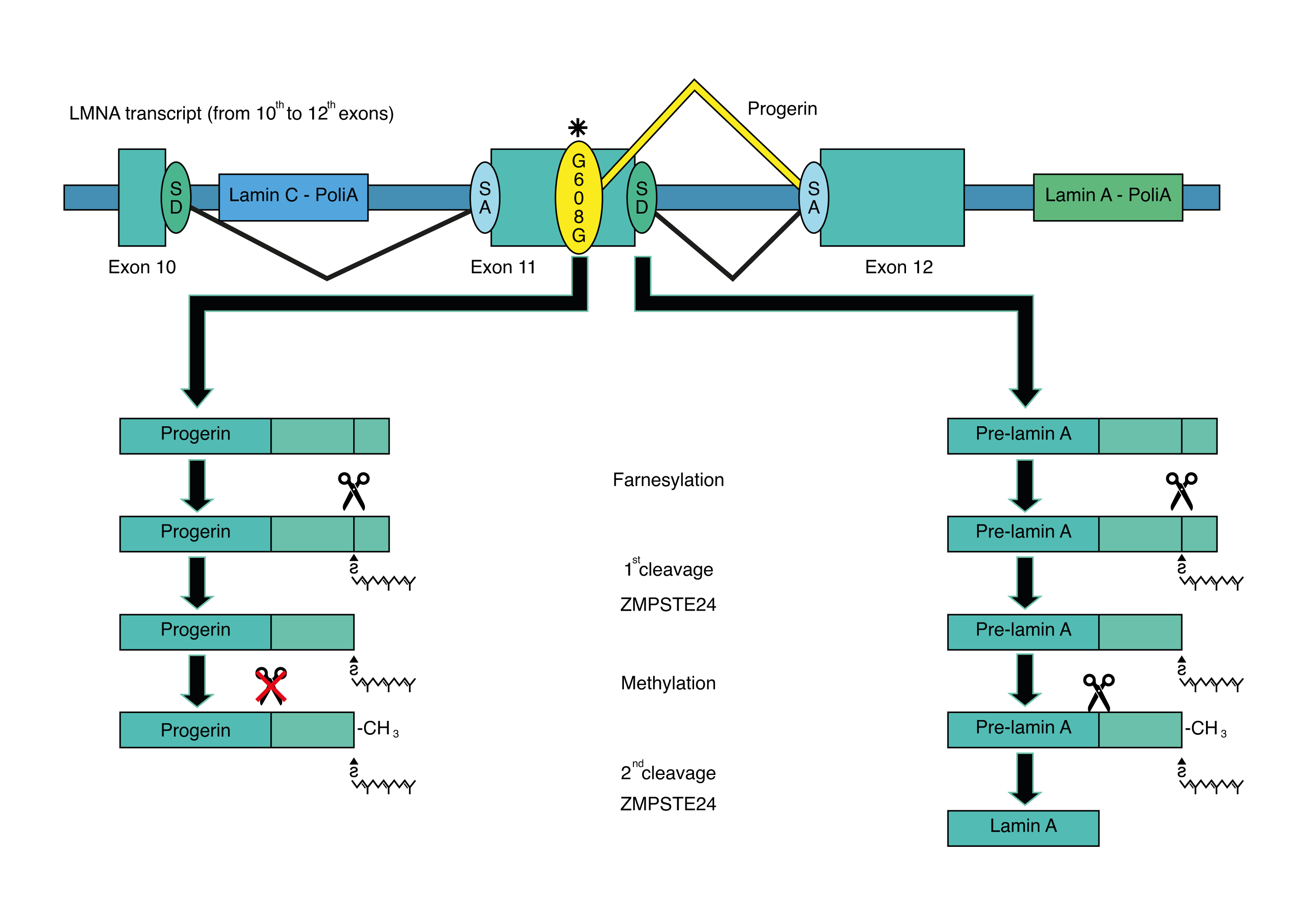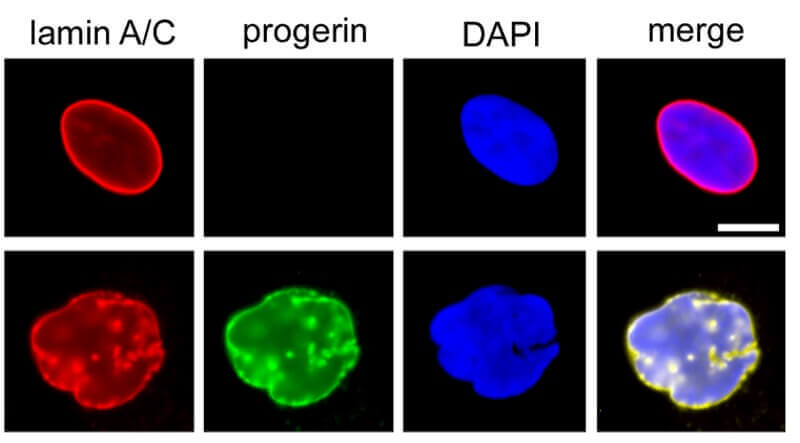Epidemiology and aetiology
Hutchinson-Gilford Progeria (HGPS) is a very rare genetic disease that affects one in every 8 million people born, and has a worldwide incidence of one in every 20 million. It is caused by a point mutation in one of the two copies of the LMNA gene present in the human genome (DNA), where a thymine replaces a cytosine (specifically in the 11th exon, at locus 1824 of the gene in question). More rarely, HGPS can be caused by other mutations in the same gene.
This means that while normally, in normal cells, only proteins called lamin A and lamin C (and two other secondary types of lamin) are produced from this gene, in the cells of a person with progeria, an aberrant form of lamin A called progerin is also produced.
Brief outline of the molecular pathways that, from the mutation in the LMNA gene, lead to cryptic splicing of the corresponding mRNA, which in turn leads to the formation of the aberrant form of lamin A called progerin.

Progerin accumulation and premature ageing
Lamin A and lamin C play a very important role in the formation of the nuclear lamina, a 'protein meshwork' that supports the nucleus of the cell itself and organises its entire genome, so that each gene can be used for the expression of proteins necessary for the functioning of the entire cell and to respond to stimuli from outside. The progerin interferes with this nuclear lamina, in fact, being recognised by the nucleus of the cell as a component of it, it is incorporated within the protein meshwork, but being aberrant it deforms it, in turn deforming the nucleus and causing the entire genome to no longer be organised in a consonant manner.
The first line shows a nucleus of a healthy cell under a microscope, of which one can appreciate the roundness and the presence of lamina A/C (in red) and the fairly homogeneous arrangement of the DNA (in blue). In the second row, again under the microscope, one can see a nucleus of a cell with progeria, of which one can see the deformation of the nuclear membrane and, in addition to the presence of laminin A/C (in red) and DNA (in blue), both arranged in a disorganised manner, the presence of progerin (in green), the aberrant form of laminin A.

The lack of organisation of the genome leads to aberrant use of many genes, which overproduce proteins that in the long run become toxic within the cell, making it weak and damaged, but above all causing even more mala-organisation of the genome together with an accumulation of mutations in it. Obviously, this accumulation of mutations can lead to the production of other aberrant proteins that in turn are a source of toxicity, increasing the problems associated with progeria, in a kind of self-feeding circle. The cells also show premature senescence for these very reasons, with a drastic slowdown in cell division.
Symptoms
With the exception of the cells of the nervous system (and therefore also of the brain), where laminin A is not expressed, and therefore neither is progerin, every cell in the body of a person with progeria is found to be malfunctioning, thus affecting neighbouring cells and forming diseased and inherently weaker tissues. How heavy the accumulation of progerin is at the molecular level can also be seen in the symptoms that progeria causes in the body as a whole. In fact, people with progeria not only have a peculiar physical appearance, but also face a variety of symptoms such as problems with osteoporosis, osteolysis and arthritis; joint capsule defects (resulting in frequent dislocations of the shoulders and hips); generalised lipodystrophy; growth and developmental retardation; skin abnormalities; alopecia; and above all, problems with the heart and blood vessels such as occlusions of major vessels, stenosis of heart valves, strokes, heart attacks and others. Taken as a whole, this symptomatology leads to what is called 'premature ageing', due to its similarity to normal physiological ageing, with which it also has profound differences, resulting in a reduced quality of life and a life expectancy of only 13.5 years without treatment.
There are currently only 130 cases of classic progeria (HGPS) recognised worldwide, of which four in Italy. However, this number is underestimated as cases of progeria are often difficult to trace, mostly in third world countries, but sometimes also in more developed countries. Current estimates of the actual number of people with progeria worldwide are around 350 cases.

Top, from right to left: Sammy Basso (Italy) and Alessandro Cavallo (Italy).Bottom, from right to left: Alexandra Peraut (Spain) and Niccolò Gherardi (Italy).
